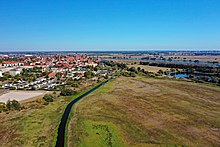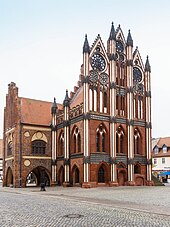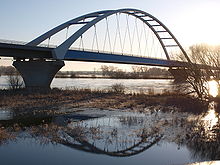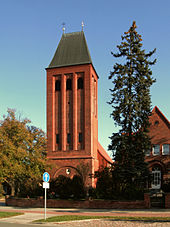Tangermünde
| coat of arms | Germany map | |
|---|---|---|

|
Coordinates: 52 ° 32 ' N , 11 ° 58' E |
|
| Basic data | ||
| State : | Saxony-Anhalt | |
| County : | Stendal | |
| Height : | 43 m above sea level NHN | |
| Area : | 89.87 km 2 | |
| Residents: | 10,319 (Dec. 31, 2019) | |
| Population density : | 115 inhabitants per km 2 | |
| Postal code : | 39590 | |
| Primaries : | 039322, 039321 (Storkau) , 039362 (book) | |
| License plate : | SDL, HV, OBG | |
| Community key : | 15 0 90 550 | |
| LOCODE : | DE TAE | |
| NUTS : | DEE0D | |
City administration address : |
Lange Str. 61 39590 Tangermünde |
|
| Website : | ||
| Mayor : | Jürgen Pyrdok ( independent ) | |
| Location of the city of Tangermünde in the Stendal district | ||
The imperial and Hanseatic city of Tangermünde is located on the Elbe in the southeast of the Stendal district in northern Saxony-Anhalt .
geography
location
Tangermünde is located southeast of Stendal in the Altmark on a plateau that was formed by a terminal moraine from the Ice Age . It is located on the left bank of the Elbe directly at the confluence of the Tangers into the Elbe, which is where the name Tangermünde comes from. The historical city center, St. Stephen's Church and the castle are safe from flooding thanks to their high elevations.
Cityscape
Tangermünde is known for the well-preserved old town with many half-timbered and brick buildings as well as for the completely preserved Tangermünde Castle and the brick fortifications.
City structure
In addition to the districts of Kehrs Ziegelei and Pappelhof, the following localities and districts (OT) have belonged to Tangermünde since January 1, 2010:
- Village Bölsdorf with the OT Bölsdorf and Köckte
- Ortschaft Buch with the OT book
- Place Grobleben with the OT Grobleben
- Hämerten locality with the OT Hämerten
- Village Langensalzwedel with the OT Langensalzwedel
- Miltern with the OT Miltern
- Village of Storkau with the OT Storkau and Billberge
history

The castle Tangermünde was first by the chronicler Bishop Thietmar of Merseburg mentioned in 1009 as "civitate Tongeremuthi", because there the Tangier (Tongera) into the Elbe flows. The first written mention of the city dates from the year 1275. Its location on a rocky terminal moraine high above the Elbe made the city a place where the Elbe tariffs were levied and later became a margravial residence.
In the 14th century Tangermünde was the second seat of Emperor Charles IV from 1373 to 1378 , who in 1373 appointed his 12-year-old son Wenzel as Elector of Brandenburg. Under him, the city was to become the capital of the central provinces, for which the emperor had Tangermünde Castle expanded as a residence. After the death of Emperor Charles IV, there was an uneasy development in the Mark until the Hohenzollern were enfeoffed with the Mark by King Sigismund as Elector in 1415 and initially resided in Tangermünde.
The heyday of the Hanseatic city was the 15th century, in which the city gates and the town hall were built in the style of the north German brick Gothic . The St. Stephen's Church was expanded into a Gothic hall church during this time . The city lost the favor of Elector Johann Cicero von Brandenburg after the rebellion of 1488 when the citizens rebelled against the beer tax . The residence was finally relocated to Cölln , where the Berlin Palace had been built since 1442 .
On September 13, 1617, the city burned down almost completely. The guilty party was - wrongly - the orphan Grete Minde , who is said to have acted in revenge for the inheritance withheld from her. She was sentenced to death and burned at the stake in 1619. Theodor Fontane inspired this event for his novella Grete Minde , published in 1880 .
After the fire, many magnificent half-timbered houses were built, whose carved portals and decorative shapes have been preserved to this day. However, due to the Thirty Years' War , the city could not maintain its importance as a trading center and became a rather insignificant country town.
After the Peace of Tilsit , the city was part of the Kingdom of Westphalia from 1807-1813 . During the founding years of the 19th century, new residential and industrial areas were built in the north of the city. In contrast to most cities in Europe, the old town core with fortifications was not touched during this time, not least because the city wall is also an embankment wall on the steeply sloping Elbe side.
Shortly after the start of the Nazi era , around 100 members of workers' organizations were rounded up and mistreated by SA men in the town hall in August 1933 . A communist citizen succumbed to the abuse.
The Second World War left relatively few traces in the city center; some valuable half-timbered houses were destroyed by US artillery fire. In the north of the city, the Elbe Bridge, completed in 1933 , was destroyed in April 1945. The Elbe could therefore only be crossed by the units of the 12th Army ( Wenck Army ) with the remnants of the 9th Army on their retreat towards the west via a narrow wooden walkway that had been built on the ruins of the bridge.
During the GDR era , the old town remained unchanged. Although the condition of the building worsened, the most important monuments were at least secured. After the fall of the Wall, the city was gradually restored. The city fountain in front of St. Stephen's Church, built in 2006, is the preliminary conclusion of this urban redevelopment. People and events from the history of Tangermünde are honored on seven of the eight panels in the fountain designed by the sculptor Karolin Donst .
population
|
|
1964–1981 result of the census , from 1990 as of December 31 of the respective year, from 2011 based on the 2011 census ; the table shows the number of inhabitants of the city without any indication of possible incorporations.
politics
City council
The city council of Tangermünde is composed of 28 city councilors and the mayor.
(As of: local election on May 26, 2019)
mayor
On April 19, 2015, Jürgen Pyrdok, who was not part of the party, was elected in the first ballot to succeed Rudolf Opitz, who has been in office since 1990. He took office on July 7, 2015.
badges and flags
The coat of arms was approved on September 8, 1995 by the Magdeburg Regional Council.
Blazon : "In silver a gold-armed, red-tongued red eagle, the Saxons each decorated with a silver rose with a golden clasp."
The small town of Tangermünde has had this coat of arms since it was founded. In its present-day representation, it resembles the shape as it was represented in the late Middle Ages . The Brandenburg eagle is also shown in the oldest seal around 1300. The two heraldic roses are additions from a later period as a distinguishing feature.
The flag is striped red and white (1: 1) with the city coat of arms.
Town twinning
Tangermünde maintains town twinning with Lich in Hessen , Minden in North Rhine-Westphalia , Tavarnelle Val di Pesa in Italy and Wissembourg (German Weißenburg) in Alsace in France .
Culture and sights
Buildings
- Castle complex with the former dance hall (from the 14th century at the time of Emperor Charles IV), chapter and prison tower
- The historic Tangermünde Town Hall , built from 1430 on the market square with its late Gothic display wall, is considered a showpiece of German brick Gothic architecture . The local history museum is also located there. Among other things, it illustrates the story of Grete Minde, who is said to have set fire to the city in 1617 and who died for it two years later at the stake.
- St. Stephen's Church with the organ by the Hamburg organ builder Hans Scherer the Elder. J. , the Gothic vaulted roof and the tallest of the city's twelve towers (and the Altmark as a whole)
- The St. Elisabeth Chapel , also known as the Salt Church, is said to have been founded under Margrave Johann I. In 1456 it was first mentioned in a document. From the beginning of the 18th century it was used as a royal salt store and granary. Today it is an event space.
- the almost completely preserved city wall with Hünerdorfer Tor , Neustädter Tor and Elbtor
- Owl Tower
- Scrap tower , a former defense tower of the city fortifications, in which shotgun pellets were made from lead until the middle of the 19th century
- Putinnen, two towers 30 meters apart on the city wall
- Rossfurt, a ravine enclosed by high lining walls from the Elbe Gate to the city, which was built in the 15th century
- Steigberg, a staircase built over the city wall by a defensive tower, an important access point to the Elbe for the residents of the medieval city
- the ruins of the Dominican monastery built in 1434
In the old town there are numerous listed buildings, including the former school building at Kirchstrasse 40 , which is now used as a restaurant .
Museums and other sights
- Castle museum in the former residence of the castle captain, the oldest surviving residence in the city, built in 1453
- Today the Salzkirche is an event space for music and art.
- The City History Museum in the historic town hall
- The Zeitzeug museum at the Eulenturm is dedicated to the everyday life of the people in the Altmark over the past 200 years.
- City fountain at St. Stephen's Church
Monuments and memorials
- Monument to Emperor Charles IV on the castle grounds, larger than life bronze sculpture by Ludwig Cauer , inaugurated in 1900
- Monument to the Elector of Brandenburg Friedrich I on the castle grounds, larger than life bronze sculpture by Ludwig Manzel , inaugurated in 1912
- Monument to Grete Minde at the historic town hall, life-size bronze sculpture by Lutz Gaede , inauguration in 2009
- Memorial in memory of the soldiers and civilian refugees who escaped the Red Army when crossing the rubble of the old Elbe bridge, which was destroyed on April 12, 1945
- Memorial stone in the city cemetery for the murder victims Ernst Drong and Fritz Schulenburg , who fell victim to Nazi terror in 1933
- Commemorative plaque on the town hall in memory of the 100 abused political opponents of the Nazi regime, highlighting the two above-mentioned dead, whose names also bear two streets
- Memorial stone in the district of Billberge in memory of two Poles who were known by name and who were deported to Germany during the Second World War and who had to do forced labor . They were hanged in 1942 for forbidden contact with German women.
Sports
With around 200 members, the city has a traditional football club , FSV Saxonia Tangermünde, founded in 1907 .
Since 2008, the Tangermünder Elbdeichmarathon has been held annually in April , with a half marathon and a 10 km run being held in addition to the marathon . With over 2000 runners, it is one of the major running events in Saxony-Anhalt.
Location for films
Tangermünde was used several times as a backdrop for films, including in the 1970s for some TV crime novels by Werner Toelcke and in 1973 for the DEFA film Rotfuchs with Angelika Waller and Jürgen Zartmann . In 2008 the city was the location for the film The Dream Couple with Jaecki Schwarz and Wolfgang Winkler . Recently there in 2016 the television movie was my brother's children by Ingo Rasper .
Economy and Infrastructure
economy
In 1826 Friedrich Theodor Meyer (1796–1884) founded the Tangermünde sugar refinery . From 1910 onwards she produced the chocolate " Feodora ", which is still produced by Hachez in Bremen today. The sugar business is operated by the company Zertus in Hamburg. The former chocolate factory was demolished in 2007.
Today's economic pillars of the city are tourism , the food industry as well as machine and shipbuilding .
traffic
Road traffic
North of the city runs the federal highway 188 (B 188), which connects Tangermünde with Stendal and Rathenow and via the B 189 also with Wittenberge and Magdeburg and the Autobahn A 2 in the direction of Berlin and Hanover. Until 2001 this federal road ran right through the city, which led to considerable traffic problems, as there was only one road bridge over the Elbe between Magdeburg and Wittenberge near Tangermünde . The construction of the new Elbe bridge and the northern bypass between 1997 and 2001 solved these problems.
The B 107 runs east of the city between Genthin and Havelberg or Pritzwalk , via which the A 2 in the direction of Berlin and the A 24 in the direction of Hamburg can also be reached.
Regular buses run by Regionalverkehrsbetriebe Westsachsen (RVW) under the brand name stendalbus .
railroad
Tangermünde and its Elbhafen were also under discussion as a possible stopping point for the Berlin-Lehrter Railway , which opened in 1871, when the contract between Prussia and the Kingdom of Hanover was signed in March 1866 , before the route was then led via Stendal further north . The connection to the hub Stendal is since 1886 the railway line Stendal-Tangermünde ago, the former by the railway company Stendal-Tangermünder was operated on which the city was instrumental to the 1945th The route was built by the Tangermünde sugar refinery to enable goods to be transported in and out. The sugar refinery in Tangermünde was one of the largest in Europe until the Second World War. Today the Deutsche Bahn operates the traffic. In Tangermünde it serves the Tangermünde and Tangermünde West stops with regional trains every hour.
A double-decker rail bus from DB Regio Südost , which was built by Waggonbau Dessau GmbH and Deutsche Waggonbau AG (DWA) Halle-Ammendorf and named "Alma", was used until 2003 . Since December 2018, operates Hanseatische Railway , the regional train line RB33 and serves the route to Stendal with Alstom Coradia LINT trains on.
Until shortly after the political change , there was a freight station in Tangermünder Hafen.
In addition, the city was connected to its western hinterland from 1903 to 1917 by the Tangermünde – Lüderitz small railway .
Denominations
The evangelical parish Tangermünde with the church St. Stephan belongs to the parish area Tangermünde in the parish of Stendal in the provost district of Stendal-Magdeburg of the Evangelical Church in Central Germany . A regional church community of the Protestant church has its seat on Albrechtstrasse. The Tangermünde father house of a free Christian congregation is on Arneburger Strasse, and a New Apostolic church is on Heerener Strasse.
The Catholic parish of St. Elisabeth in the city belongs to the deanery of Stendal. The Church of the Most Holy Trinity on Arneburger Strasse, built in 1924-26 in the neo-Romanesque style, belongs to it in Tangermünde . Before that, the church of St. Elisabeth am Zollensteig, which has since been secularized , was used from 1891 to 1926 .
The historic Nikolaikirche next to the Neustädter Tor was profaned, the building is now a restaurant with a medieval ambience.
According to the 2011 census in the European Union , of the 10,648 inhabitants of the city of Tangermünde, around 15.3% were Protestant and around 2.6% Catholic; the majority of the inhabitants belonged to neither of the two denominations.
Personalities
sons and daughters of the town
- Johann von Buch (around 1290–1356), judge and most important glossator of the Saxon mirror (Buch's glossary)
- Friedrich II. (1413–1471), Elector of Brandenburg
- Albrecht Achilles (1414–1486), Elector of Brandenburg
- Magdalena von Brandenburg (1460–1496) , Princess of Brandenburg and by marriage Countess von Hohenzollern
- Grete Minde († 1619 executed), historical figure
- Johann Dietrich Sprecher (1674–1727), orientalist
- Carl Lebrecht Noething (1717–1797), Chamber Clerk
- Samuel Gottfried Borsche (1767–1821), civil servant and councilor
- Ludwig von Borstell (1773–1844), General
- Friedrich Ludwig III. Truchsess zu Waldburg (1776–1844), patron of Ludwig van Beethoven
- Wilhelm Floto (1812–1869), pharmacist and comedy writer
- Max Rötger (1830–1886), civil servant
- Wilhelm von Becker (1835–1924), politician, mayor of Düsseldorf and Cologne
- Conrad Steinbrecht (1849–1923), architect, construction officer and preservationist
- Carl Heins (1859–1923), pianist and composer
- Friedrich Theodor Meyer (1870–1928), manager, councilor and honorary citizen of Tangermünde
- Wilhelm Bartz (1881–1929), politician, member of the Reichstag
- Fritz Schröder (1891–1937), politician (SPD)
- Konrad Meyer (1902–1972), politician (CDU)
- Walter Meyer (1904–1949), rower, Olympic champion
- Hansgünter Meyer (1929–2015), sociologist and university professor
- Burghard Stück (1929–2008), pediatrician and immunologist
- Reinhold Haberlandt (1936–2019), physicist
- Almuth Berger (* 1943), theologian and commissioner for foreigners in the GDR
- Falco Werkentin (* 1944), sociologist and historian
- Andreas Mehl (* 1945), ancient historian
- Ingo Schulze (* 1948), marathon runner and sports organizer
- Reinhard Weis (* 1949), politician (SPD)
- Michael Liwowski (1951–2011), Member of the State Parliament (CDU)
- Tatjana Meissner (* 1961), cabaret artist, television presenter and author
- Laura Müller (* 2000), It girl and reality show participant
People connected to the city
- Charles IV (1316–1378), Roman-German Emperor , set up an imperial palace in the old castle
- Johann III. von Blankenfelde (1507–1579), Mayor of Berlin , worked for several years as a tax officer in Tangermünde
- Otto von Grote (1620–1687) member of the Fruit Bringing Society, was governor of the Kurbrandenburg region in Tangermünde
- Wilhelm Zahn (1848–1911), pastor and archaeologist, lived and worked in the city for a long time
- Wilhelm Mehl (1893–1940), teacher and local history researcher, lived and worked in the city
literature
- Sigrid Brückner (Ed.): Tangermünde - 1000 years of history . Janos Stekovics, Dößel 2008, ISBN 978-3-89923-217-2 .
- Heinrich Trost: Tangermünde ( art history city books ). Leipzig 1965.
Web links
Individual evidence
- ↑ State Statistical Office Saxony-Anhalt, population of the municipalities - as of December 31, 2019 (PDF) (update) ( help ).
- ↑ StBA: Area changes from January 01 to December 31, 2010
- ^ End of the war in Leipzig . Spiegel Online , April 24, 2015, (multimedia format).
- ↑ State Statistical Office of Saxony-Anhalt: Population movements (click on municipalities)
- ↑ tangermuende.de
- ↑ Final result of the city council and local elections. tangermuende.de, accessed on March 31, 2020
- ↑ Official website of the city of Tangermünde ( Memento from April 24, 2015 in the web archive archive.today ), accessed on April 24, 2015.
- ↑ Trailer for the film "Red Fox"
- ^ Volksstimme , website
- ↑ Cf. Wolfgang Philipps: "The best connecting line between the east and the west". Political background of the Berlin-Lehrter Railway. In: Lehrter Land & People: Magazine on history, culture and local history. Volume 42 (2014), pp. 14–16, here p. 16.
- ↑ Tangermünde parish area. Retrieved May 11, 2018 .














